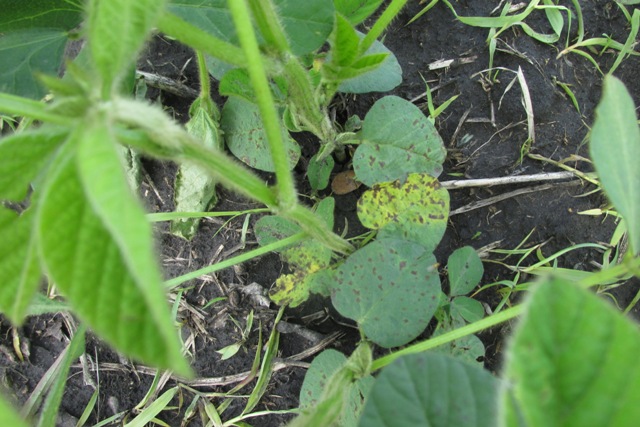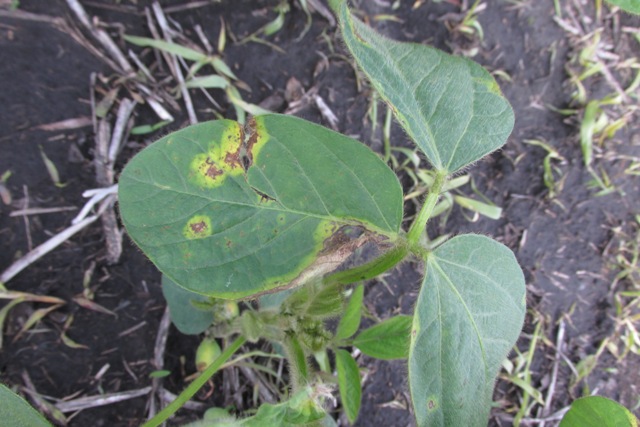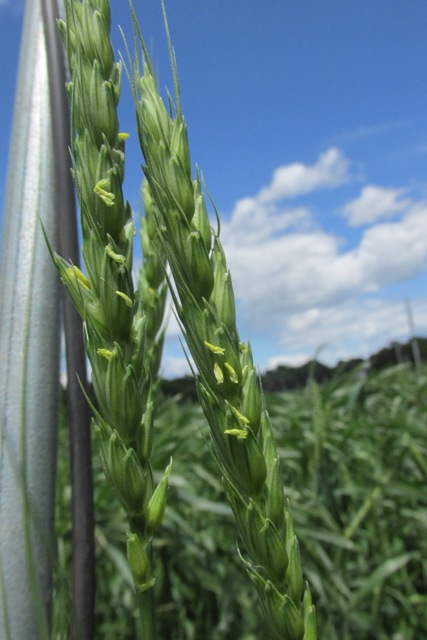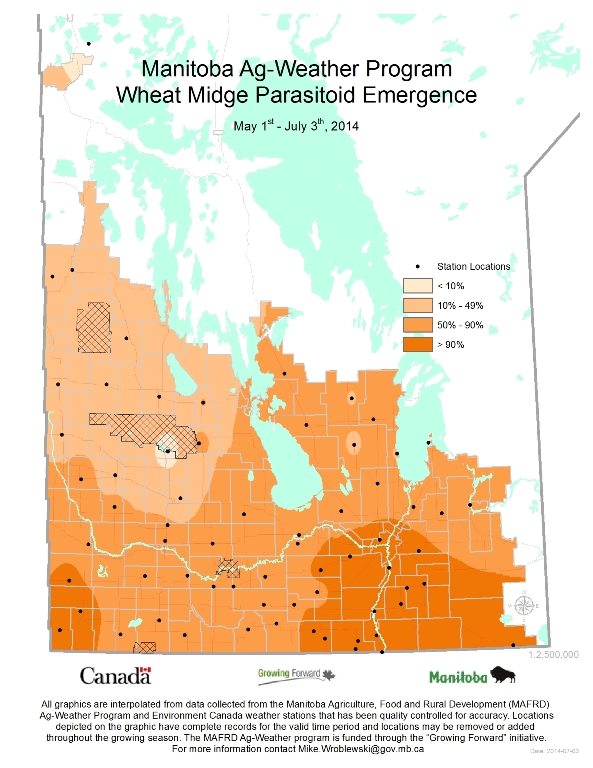Manitoba Insect and Disease Update: July 2, 2014
Compiled by:
- John Gavloski, Entomologist
Manitoba Agriculture, Food and Rural Development
Phone: (204) 745-5668
Fax: (204) 745-5690. - Vikram Bisht, Plant Pathologist
Manitoba Agriculture, Food and Rural Development
Phone: (204) 745-0260
Fax: (204) 745-5690
To report observations on insects or plant pathogens that may be of interest or importance to farmers and agronomists in Manitoba, please send messages to the above contact address.
To be placed on an E-mail list so you will be notified immediately when new Manitoba Insect and Disease Updates are posted, please contact John Gavloski at the address or numbers listed above.
To be placed on an E-mail list so you will be notified immediately when new Manitoba Insect and Disease Updates are posted, please contact John Gavloski at the address or numbers listed above.
Summary
Plant Pathology: Soybean brown spot and bacterial blight are showing up in more fields. Tan spot and Septoria leaf spots are showing up in the lower canopy in many crops; few with flag leaf spotting. The risk for Fusarium head blight is still very high. Crop scouting is necessary to correctly time the fungicide application.
Insects: Prior to the heavy rain on the weekend, grasshoppers were the biggest insect concern, with some control measures being taken, mainly along field edges. We will now have to assess what effects the heavy rains have had on populations of insects such as grasshoppers and diamondback moth.
Soybean Diseases
Brown spot disease (Septoria) is being observed in V3-V5 soybean plants in a few fields (Fig 1). With plenty of rains in the last few days, with thunderstorms in some areas, early spots of bacterial leaf blight (Fig 2) is also being seen, mostly on the upper foliage.

Fig. 1. Brown spot disease on lower leaves of canopy. Photo courtesy: Vikram Bisht, MAFRD

Fig. 2. Soybean bacterial blight leaf spots on the upper foliage. Photo courtesy: Vikram Bisht, MAFRD
Wheat Diseases
Wheat is flowering in many areas of Manitoba (Fig 3) and the conditions are extremely favourable for Fusarium head blight. Please check the risk map and scout the flowering stage of the fields to properly time the fungicide application. If the winter wheat crops or early planted spring crops are heading or just started flowering in your fields, fungicide application should be considered, since the Fusarium head blight risk is generally high to extremely high. Frequent and scattered rains throughout the province, in the last few days, would have helped release of Fusarium spores into the air from infected crop residue.

Fig.3. Early anthesis on heads. Photo courtesy: Vikram Bisht, MAFRD
The Fusarium Head Blight Risk Forecast webpage is up and running at http://www.gov.mb.ca/agriculture/crops/fhb/index.html.
Effects of Flooding on Grasshoppers
Once grasshoppers have hatched, how vulnerable they are to moisture depends on the stage of the grasshoppers when the moisture arrives, and the length and intensity of the event. Immediately after grasshoppers hatch they have few fat reserves and are vulnerable to cool, wet weather. If they are unable to feed readily during these early stages, high mortality will result.
Studies in Nebraska on 7 species of grasshoppers looked at how long grasshoppers needed to be immersed under water before they would be killed. The LT50 (time it takes for 50% of the population to be killed) ranged from 7.5 to 21 hours for adults, while nymphs had an LT50 of between 3 and 13 hours. These survival times indicate that mortality associated with seasonal rainfall would rarely be caused by immersion, however in some areas this year grasshopper mortality by immersion is a possibility.
Grasshoppers thrive under hot dry conditions, and are very vulnerable to disease under prolonged periods of cool wet conditions. If cool wet weather persists for a couple of weeks the grasshopper population could be reduced significantly, particularly by a fungus that infects the grasshoppers under these humid conditions. If periods of sunny and drier weather allow the grasshoppers to dry off then they are less susceptible to disease.
Regarding early-season, springtime flooding, the eggs of some species of grasshoppers can survive immersed in water for at least several days. One study from Montana concluded “even if grasshopper egg pods were submerged for weeks, some would still hatch”. Experiments in Lethbridge, Alberta concluded that “complete immersion in water for days did not kill the eggs or slow subsequent growth”. Other studies indicate that “spring floods can cause high egg mortality if they occur after diapause has been broken”. So a flooded area does not necessarily mean no grasshoppers will hatch from the area, especially early-season flooding.
Effects of Flooding on Wireworms
Studies in the United States have found that wireworms can be controlled by flooding, but the results are not always consistent and may depend on other environmental factors. A study in British Columbia looked at the effect of temperature and soil on the control of wireworms by flooding. They found that wireworms submerged at higher temperatures died quicker than those submerged at lower temperatures, and soil salinity may affect the effectiveness of flooding as a control strategy. Flooding at 5ºC required about 2 month (55 to 62 days depending on soil type) to kill 90% of the wireworms. In contrast, flooding between 10ºC and 20ºC required between 9 and 26 days to kill 90% of the wireworms, depending on soil type. So flooding in the summer, when temperatures are warmer, has a better chance of reducing wireworm populations than flooding under cooler temperatures.
Wheat Midge Emergence Forecast
The emergence of adult wheat midge can be estimated using degree-day calculations, although rainfall in May and June can affect the accuracy of these calculations. With a 5 °C base temperature, accumulated degree-days (DD) for 10%, 50% and 90% emergence of wheat midge average 693 DD, 784 DD and 874 DD, respectively. Emergence can be 2–8 days later than expected at sites receiving more than 145 mm rain in May and June (Elliott et al. 2009. Crop Protection. 588-594). As the map below demonstrates, emergence of wheat midge is not likely to have begun yet. Further delays may occur because of excess rain in many areas.

Emergence of Maroglenes Penetrans - an important parasitoid of Wheat Midge
Degree-days can also be used to estimate emergence of Macroglenes penetrans, the most important parasitoid of wheat midge. As the map below shows, the emergence of Macroglenes penetrans should already be underway. This is normally the situation, where emergence of Macroglenes is well underway before wheat midge begins emerging. However, it is also worth noting that in the research on degree-days for Macroglenes, in most instances, wasps emerged 1–11 days later than expected at sites that received more than 145 mm rain in May and June.

